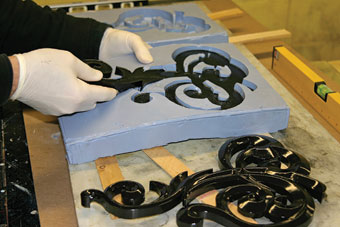 Jim Hingst
Jim Hingst
I never was able to see the value of the molding and casting process—that is, until I recently visited Chicago artist Chris Maylone at his studio on the city’s upscale North Side. He had just taken an order to produce twenty-five hand-carved Christmas trees for a retailer. Carving just one would involve tedious detail; carving twenty-five of the same thing would’ve been maddening.
By creating a mold of his carving, Maylone could cast exact “spitting image” copies of his original Christmas tree, finish the job on schedule, and actually make a respectable profit. More importantly, the castings were harder and more durable than the original high-density urethane (HDU) carving.
If you’re carving a part that you’ll likely use time and time again (such as an appliqué for a sign), knowing how to create a mold and cast parts can be a money-maker for you. In this article, I’ll describe a three-part procedure that I learned from master sign carver and gilder Dr. Francis Lestingi: (1.) creating the model, (2.) making the mold, and (3.) casting the duplicate.
Creating the Model
When carving the original model, make sure that the sides of the carving are perfectly perpendicular with no undercuts; that way, you can easily eject the parts from the mold. (Note: HDU is commonly used here because it’s very easy to carve.)
After you’ve carved the model, lightly sand it. Don’t overdo it or you’ll destroy the character of the carving.
To prepare HDU models for casting, prime the piece with two or three coats of Sign•Prime™, Jay Cooke’s All-Purpose Primer, or 1-Shot® Chromatic Hi-Build Primer. These primers are designed to fill in the rough texture of the HDU, yielding a smooth finish. Water-based primers typically dry in one to two hours, depending on the thickness of the coating and the temperature and humidity in your shop. High humidity above 80 percent can cause drying problems.
After the final coat of primer is thoroughly dry, lightly sand the surface with 320-grit sandpaper.
After wiping the sanded surface with a tack rag, paint the model with a thick coat of a Ronan Paints bulletin color. Dr. Lestingi thickens the paint by leaving the lid off the can to evaporate some of the solvent in the paint. Once you’ve painted the model, it’s now ready for the casting process.
If Dr. Lestingi is carving a piece with intricate detail, he generally prefers using Extira®, a treated exterior composite material comprised of 90 percent wood impregnated with a phenolic resin and zinc borate. “Extira carves just like wood, but you don’t have to contend with the grain,” he says. “Extira won’t crumble when you carve it, which occasionally happens when you work with a foam board.”
Although Extira is water-resistant, it’s primarily wood—which is porous. So you must seal the surface, if you use it to make a model for a mold.
Several coats of primer and paint will give carved Extira a very smooth surface (essential when making a mold). Any imperfections in the mold will be duplicated on the surface of the cast piece and will become even more apparent when the piece is gilded.
Sign makers have primed Extira using either a high-quality, oil-based primer or acrylic latex primers. Finish coats must be compatible with the primer coats.
Priming an Extira Carving
1. To remove any contaminants from the surface, wash the Extira with soap and water and rinse with water.
2. Lightly sand the surface. Knock down any sharp edges, because these are areas prone to paint adhesion failure.
3. After sanding, lightly wipe the surface with a clean tack rag to remove any residual dust. Don’t vigorously rub the surface with the tack rag or you’ll contaminate it with some of the sticky stuff on the rag. Also don’t wipe the surface with a rag saturated with solvent. While Extira won’t absorb water, it will absorb the solvent, which could cause the panel to swell as well as inhibit adhesion of the primer and finish paint. ([I]Note:[I\] Be sure to wear all required safety equipment, such as latex gloves and air respirator, and work in a well ventilated area of your shop.
4. Thoroughly stir the primer and paint before use. Generally the optimal ambient temperature is 70ºF or 21ºC. Temperatures below 55ºF or 13ºC can be problematic for some coatings. Typically two or three coats of primer are required for either Extira or HDU).
5. After the final coat of primer has dried, lightly sand the surface with 320-grit sandpaper to ensure good intercoat adhesion between the paint and primer.
6. Top coat the surface with one to two finish coats. Dr. Lestingi routinely paints this with a base coat of black Ronan bulletin paint.
Making the Mold
Making a mold isn’t difficult to learn, but it does require strict attention to detail.
Step 1. Whether you’re creating a mold or casting, you must work on a level surface. “As my work surface, I use a piece of painted 3/4-inch MDO,” says Dr. Lestingi. “On the bottom of the board, I’ve attached four levelers that I picked up at Home Depot.”
Step 2. Next create a “confinement field barrier” or mold box to contain the liquid rubber until it cures and solidifies. “You can use four L-shaped wooden sections to create an adjustable mold box around your model,” says Dr. Lestingi. “You can build the L-shaped pieces using two-by-fours or 3/4-inch MDO plywood.
(Note: To contain the liquid rubber poured around and over your model, you can also use other types of canisters, such as plastic food containers, coffee cans, or a plastic bucket. In selecting one of these containers, just make sure that it’s sufficiently large enough to provide 1/2-inch clearance all the way around your model.)
Step 3. Clamp the four L-shaped pieces together using clamps (spring clamps or C-clamps).
Step 4. In positioning the model inside the confinement field barrier, allow at least a 1/2-inch space around the entire piece. Then secure the model to your work surface either through screwing from the bottom or using hot melt glue. “Double-sided carpet tape works best for me,” says Dr. Lestingi.
Step 5. Seal the edges of the confinement field barrier wherever the L-shaped pieces join together and along the perimeter of the mold box between the pieces and the work surface with hot melt glue. “An alternative is to use silicone to seal the edges,” says Dr. Lestingi. “The problem with silicone is the potential of an adverse chemical reaction with the mold compound.”
Sealing the edges is critical. Failure to create a good seal will result in leakage of the silicone rubber mold material, which wastes material, time, and money.
Step 6. Estimate the material required to make the mold. If you don’t mix enough, you may need to start over from scratch, in which case, all the time and material invested up to then is lost. Trying to compensate by mixing more than enough is not only unnecessary, but it also wastes material and adds to the cost to produce the job.
Mixing just the right amount is the most sensible and cost-effective approach.
“[The] approach involves a little high school math, which shouldn’t be too difficult for most people,” says Dr. Lestingi. “For those who are mathematically challenged—or if it’s been a while since graduation day—just ask your granddaughter to help you with your calculations.”
The simple way to determine the amount needed is to fill the confinement area with water. Then pour it out into a measuring beaker. Divide your measurement by two because both Smooth-On OOMOO™ 25 and OOMOO 30 are two-part silicone rubber compounds, which are combined in equal amounts. Make sure to dry the confinement area completely or the water will react with the mold ingredients causing bubbles.
The faster, more trouble-free way to determine the amount needed is to do the math. Here is the step-by-step explanation of the calculations that you will need to make:
A. Multiply length of the confinement area by the width and the height of the model plus an additional 1/2-inch. This will give you the volume in cubic inches.
L * W * H = cubic inches
Example: 9.25” x 10” x 1.5” = 137.75 inches³
B. Next convert cubic inches to gallons. Since one cubic inch equals 0.004329004 gallons, multiply that number by the cubic inches calculated in the previous step.
Example: 137.75 inches³ * 0.004329004 gallons = 0.59632 gallons
C. Finally, to convert gallons to fluid ounces, multiply gallons by 128, which is the number of ounces in a gallon.
Example: 0.59632 gallons * 128 fluid oz. = 76.329 fluid oz.
 In pouring the mixed ingredients into the mold, start at the lowest point in the containment area. Continue to pour all of the material in that one spot and be sure not to move while pouring.
In pouring the mixed ingredients into the mold, start at the lowest point in the containment area. Continue to pour all of the material in that one spot and be sure not to move while pouring.
By pouring in one place, you’ll push all of the air out of the mold box. This ensures that no air pockets will form. (Note: Also don’t pour the resin directly on top of the model or you could trap air bubbles.)
After you’ve poured the molding compound, wait overnight for the mold to thoroughly cure.
The next day, unclamp the L-shaped pieces and carefully pry the sections from the formed mold and the work surface.
To release the model from the mold, gently flex the edges of the rubber mold. Just before use, wipe the mold to remove anything that doesn’t belong there.
Cast the Duplicate
For the casting process, Dr. Lestingi recommends using Smooth-Cast® 300, a durable urethane casting plastic. Just as the molding materials come in a two-part formulation, the casting compound has a Part “A” and a Part “B.” These parts are mixed at a 1:1 ratio. (Caution: Part “A” of the Smooth-Cast 300 contains Methylene Diphenyl Isocyanate, so avoid contact with your eyes, skin, or mucous membranes and don’t breathe in the fumes).
Over the years, Dr. Lestingi has modified his procedures for mold making and casting. One change that he has made is to add colorant to the casting compound rather than paint the duplicate pieces. He feels that this saves time and money and produces a better finished product.
Dr. Lestingi uses Smooth-On SO-Strong® colorants. Available in eight tints (black, brown, yellow, purple, green, orange, red, and blue) and two opaque colors (white and fleshtone), the colorant is added directly to the “B” component.
To get the color you want, you can add up to three percent of the colorant to the total volume. Don’t overdo it or the silicone rubber may not cure properly.
Step 1. Determine the amount of casting material needed. Just fill the cavity of the mold with water and pour into a graduated beaker.
The amount of water is equal to the amount of casting material that you’ll need. In the interest of keeping good records, mark the amount needed to fill the cavity on the side of the mold with a Sharpie® pen.
Before you start casting, the mold must be completely dry. Any residual moisture will react with the resin, causing it to foam and resulting in bubbles on the surface of the casting.
Step 2. Divide the amount of water measured by two, because you’ll need to mix equal amounts of part A and part B of the two casting ingredients.
Step 3. Shake both jugs of the components to ensure that all of the ingredients are well mixed.
Step 4. Measure the amount of water that corresponds to the amount of one of the ingredients needed.
Step 5. Pour the water into a clear plastic cup and, using a fine-tip Sharpie, mark a line at the height of the water level. Do the same with another clear plastic cup.
Step 6. After drying the cups, pour equal amounts of part A in one cup and part B in another cup.
Step 7. Combine part A and part B in a third cup. Quickly mix the two components for forty-five seconds. Using either a chopstick or a craft (Popsicle) stick, mix the ingredients well and make sure that you scrape the sides and bottom of the mixing container.
When you’ve started working with the casting product, you won’t have time to take a coffee break. The pot life of the mixture is only two to three minutes. In that very short period of time, you must mix the ingredients and pour it into the mold. If you wait too long, the resin will set up in the container before you pour it.
Be very careful when handling the mixed components. Even after the resin has cured, it will continue to generate heat as the cast part cures.
Step 8. Pour the casting compound into the mold and wait fifteen minutes for the casting material to harden. If you feel the mold and it feels warm, the resin is still curing. Wait until the piece is fully cured.
Step 9. Carefully remove the duplicate piece from the mold by gently pressing along the edges. To helps eject the piece, you can also press the bottom of the mold to force the piece out. (Note: If you’re using a polyurethane mold, you must lightly spray the entire cavity of the mold with a release agent prior to casting. Then using a brush, coat all of the deep recesses of the cavity with the release agent. Finally repeat the procedure.)
Step 10. Wash the duplicate piece with detergent and water to clean any contaminant on the surface of the part. If the molded piece has some rough spots, you can lightly sand these areas smooth.
Step 11. Put your supplies away. Once you’ve opened the two components of the casting resin, the atmosphere will start to oxide the ingredients, and they’ll start to degrade. You can extend the shelf life of the product by spraying XTEND-IT™ Dry Gas Blanket (available from Smooth-On) into the container to prevent oxidation. Immediately after spraying the gas, replace the lid. 
If you need to paint the cast part, Dr. Lestingi recommends Krylon Fusion paint. This aerosol paint was formulated specifically to bond to plastic surfaces, which makes it a great choice for painting cast pieces.
Before spray painting, don’t forget to prep the surface. Prepping plastic for painting is a lot like prepping an automotive surface before applying vinyl graphics. Here’s how:
First wash the surface down with hot water and detergent. This will clean any water soluble contaminants as well as any mold release agents, that you may have used. Cleaning with a solvent, such as a mild wax and grease remover will dissolve any remaining contaminants. Any oily film that the solvent leaves will be washed off with a final cleaning of isopropyl alcohol (IPA).
If you need to sand the part before painting, wipe off any dust with a tack rag and then wash the surface down again with IPA. While sanding will remove any unwanted imperfections, it also slightly scuffs the surface giving the plastic some tooth for the paint to bite into.
Following his surface preparation, Dr. Lestingi then sprays two coats of Krylon. The first coat acts as a primer. The second is the finish coat. One advantage of the Krylon Fusion paint is that it dries fast. After an hour, the painted part should be dry enough to handle.
Krylon Fusion comes in at least sixteen colors. Because Dr. Lestingi gilds most of his cast appliqués, he prefers painting the parts black. That way, if he has any holidays or voids in his gild, he can spot them immediately.
Step 12. To attach the painted or gilded appliqué, Dr. Lestingi affixes threaded studs to the cast parts. To adhere the appliqués to the sign, he drills holes for the studs. After filling the holes with silicone sealant and adhesive, he completes the installation.











